Eliza Knight's Blog, page 50
August 28, 2012
The Rose Garden by Susanna Kearsley -- $1.99 today only!
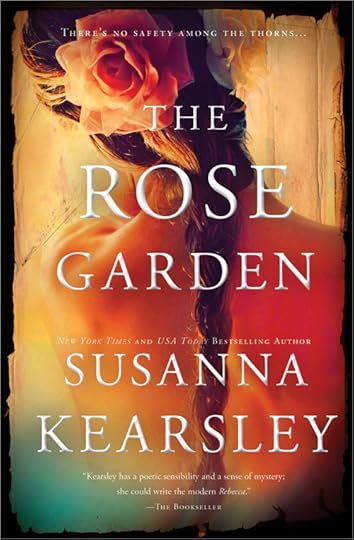 Today on Nook, The Rose Garden by Susanna Kearsley is only $1.99!
Today on Nook, The Rose Garden by Susanna Kearsley is only $1.99!Remember you can read Nook on your Nook, but you can also download Nook apps for free and read Nook books on your Android, IPad, IPhone, Mac or PC! Don't miss out on this awesome book! We at History Undressed loved it and our review is forthcoming.
Cheers!
Eliza
Published on August 28, 2012 04:30
Historical Romance Review: A Perfect Knight for Love by Jackie Ivie
 ABOUT THE BOOK:
ABOUT THE BOOK:Deep in the Scottish Highlands, a stalwart clansman and a wayward bride confront duty and desire…
A Man Of Misfortune
With his reckless, drunken brother bringing ruin to the clan, and the lass he’s loved all his life in the clutches of a violent husband, the last thing Thayne MacGowan needs is a spirited, sharp-tongued damsel to contend with—no matter how enticing she may be…
A Woman With A Secret
Having narrowly escaped an objectionable arranged marriage, Amalie is starting a new life—with a new identity. But her freedom is cut short when a surly but irresistibly handsome Highlander is forced to take her as his bride. If only he knew who she really was…
An Unlikely Love
Fate designs an improbable match, and a battle of wills ensues. As Amalie struggles to protect her identity, Thayne finds himself fighting for an unexpected love—and a passion neither can refuse…
ISBN: 978-1-4201-2400-2 On Sale Date: September 4, 2012Kensington, Zebra -- Paperback
MY REVIEW:Ms. Ivie has penned a compelling, passionate tale of adventure, love and loyalty. Amalie and Thayne are larger than life, each with their own views on how the world should work--which just so happen to conflict with one another.
Amalie, a lady born of English Society, takes on the disguise of a governess, escaping an unwanted marriage. She travels to Scotland to become a governess--which seems all well an good, but the clothes are not what she'd prefer! Literally, she lands in the arms of the hero and is swiftly thrust into a dangerous adventure. Highlanders, battles, enemies, lies. All of it, and she does the best thing she knows how--acts her way out of it, or so she thinks. In fact, she'll end up embroiling herself further.
Thayne is a seasoned warrior, a tougher than tough Highlander, who seems to undergo an immeasurable amount of pain both physically and emotionally and still can be gentle with his heroine. He owns every page he graces. A bit brutish on the outside, inside Thayne has a heart of gold--even if he doesn't believe Amalie is who she says she is.
Great descriptions of castles, decor, clothing, the Scottish countryside. The scenery was vivid and truly popped. This was a nice escape story. I thoroughly enjoyed it and look forward to reading more of Ms. Ivie's work.
Published on August 28, 2012 03:45
Anna Bentley Tremaine's Guest Historical Review of The Braham's Deception by Louise Marley
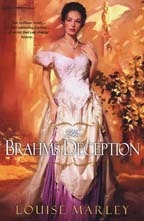 ABOUT THE BOOK: The Braham’s Deception by Louise Marley
ABOUT THE BOOK: The Braham’s Deception by Louise MarleyMusic scholar Frederica Bannister is thrilled when she beats her bitter rival, Kristian North, for the chance to be transferred back to 1861 Tuscany to observe firsthand the brilliant Johannes Brahms. Frederica will not only get to see Brahms in his prime; she’ll also try to solve a mystery that has baffled music experts for years.
But once in Tuscany, Frederica’s grip on reality quickly unravels. She instantly falls under Brahms’ spell—and finds herself envious of his secret paramour, the beautiful, celebrated concert pianist Clara Schumann. In a single move, Frederica makes a bold and shocking decision that changes everything…
When Frederica fails to return home, it is Kristian North who is sent back in time to Tuscany to find her. There, Kristian discovers that Frederica indeed holds the key to unraveling Brahms’ greatest secret. But now, Frederica has a dark secret of her own—one that puts everyone around her in devastating peril...
Kensington Books, Trade PaperbackISBN: 978-0-7582-6567-8
Anna Bentley Tremaine's Guest Historical Review:This book is first and foremost a cautionary tale about interfering with the past. It is a story of disappointed hopes and abusing power in an attempt to get ahead. Kristian, the hero, who's just left the ivory tower without completing his PhD, is asked to step back in time to find out what happened to his rival when she didn't return as scheduled. The story centers strongly around music, but the author is careful not to overwhelm lay readers with terminology that might prevent them from enjoying or understanding the writing.
Unfortunately, the book did not work for me. The characters felt constructed and cliched rather than real. The author made almost all the "bad" people ugly, rich, and controlling while the "good" people were beautiful, poor, and noble. I did not care for the fact that the hero kept a very important secret for as long as he did. Most of all, I didn't care for the idea that we could go back to witness the past as ghostly spirits who could not be perceived by anyone around us. While one of the concerns of the story was preservation of the established timeline, it did not once touch on on the ethics of going back in time to watch people who could not give their consent to being watched.
Published on August 28, 2012 03:34
August 21, 2012
Video of the Week: Terry Jones Medieval Lives -- The King
Terry Jones is hilarious, I love his take on history! Makes learning entertaining! So enjoy this video on Medieval Kings--be wary, this video is about 30 minutes long, so you may wish to watch it over lunch or when you need a break!
Enjoy!

Enjoy!
Published on August 21, 2012 05:15
August 20, 2012
A Bit of History Behind THE EAGLE'S WOMAN by Miriam Newman
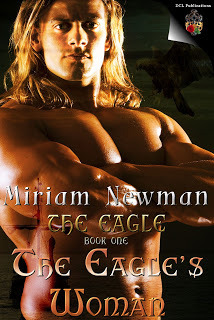 Welcome back to History Undressed, guest author and friend, Miriam Newman! Today she's sharing with us a bit of history behind her new medieval romance, THE EAGLE'S WOMAN! Take it away, Miriam!
Welcome back to History Undressed, guest author and friend, Miriam Newman! Today she's sharing with us a bit of history behind her new medieval romance, THE EAGLE'S WOMAN! Take it away, Miriam!
*****
My new release, The Eagle’s Woman, is a project that has long been in my mind. Book I of a series to be titled The Eagle, it begins the journey of Ari and Maeve.
The year is 856 A.D. Son of an impoverished, ailing Norse chieftain, Ari raids for booty and slaves in order to feed his people. Pagan himself, still he spares priests although he sells them. He is a heathen…a murderer. It is a sin for any Christian woman to love him.
Maeve is the simple daughter of simple people, from an Irish fishing village so remote it has never experienced a raid. She has heard of Vikings, but never seen one. That is about to change.
EXCERPT:
“What?” Ari asked, reaching with his free hand to take her chin in it. His thumb caressed her bottom lip and she thought she was not out of danger with him, no matter how disheveled her appearance. This man wanted her, no doubt of it. Not enough to commit violence on her, apparently, but she thought gentleness held its own dangers. If she was not careful, it could weaken her will. He was not unattractive—with fair skin, strong angular features and striking eyes—though just then he looked like a drowned rat as all of them did. It did not obscure the strength of his body or the keen intelligence in those eyes. She turned her head to the side, dislodging his thumb.“I have not seen tears from you before,” he said thoughtfully, “though many of the others are crying. What has finally broken you?”“I am not broken,” she spat, “only mourning two good people who raised me. But I am sure you know nothing of such feelings.”He sat back on his heels. “Do I not? Two good people raised me as well. One lies crippled in his sickbed and the other waits for me to bring coin to buy things a sick man needs.”Maeve was silent, surprised and momentarily chastened. She had never seriously supposed he had motives other than greed.“Do you think raiding is worthy of a fighting man?” he persisted. “I would rather face an army than hungry children.”She stifled an impulse toward sympathy. “Ours are dead or captive. You seem to have no trouble facing that.”Abruptly, he set both feet beneath himself and got up, undaunted by the motion of the ship which made such things impossible for Maeve. She had not noticed a wineskin hanging from the rigging, but she saw him reach for it then. “I cannot help your children.” He took a fulsome swig. “Just mine.” Wiping the neck with his wet tunic, he held the wineskin out to her.It was decent wine, probably from their monastery, tasting of strength and summer. She needed strength to remember that summer would come again, so she drank.
BACKGROUND:
I was amazed and a little intimidated when I first began researching this book and realized just how much work bringing that back-of-my-mind dream was going to entail. I knew about the Viking longships, the Berserkers…I even had a notion about how their concept of trial by judge would filter down into English Common Law via the Norman invasion to become our modern trial-by-jury. This will come into play in Book II, The Eagle’s Lady.But I didn’t know much about the private code of conduct so integral to Viking life. Viking society was permeated by the notion of honor, or drengskapr, and shame, or nior. In stark contrast to our present-day image of heated Berserker frenzy in battle, the Viking in his private life was valued for self control, bravery, generosity, sense of fair play and respect for the right way of doing things. A stoic and imperturbable manner was considered highly honorable. Cowardice, treachery, kin-killing and oath-breaking constituted dishonorable, shameful behavior that could even result in temporary or permanent banishment. Taunts issued through—of all things—poetry could get you outlawed, and accusing another man of effeminate behavior was signing your own death warrant. Viking law allowed for lethal reprisal.Matters of honor were often settled by duel with swords, spears and axes. This took place before witnesses in the context of a carefully orchestrated ritual. In Iceland, men were required to duel within the area which could be covered by a cloak, often on a small island in a river, which prevented retreat or interference. The first man to become disarmed was the loser. If his opponent then cut him down, he could be outlawed, which meant he was banished and was essentially free game to anyone who wished to kill him, and someone usually did. Again, this will come into play in my second book of the series. Quite a difference from our image of the out-of-control raider decimating peaceful villages, isn't it?
SEE “THE EAGLE’S WOMAN” AT THE FOLLOWING LINKS:
http://www.allromanceebooks.com/product-theeagle039swoman-904928-162.htmlhttp://www.fictionwise.com/ebooks/b134393/?si=0http://www.amazon.com/The-Eagles-Woman-ebook/dp/B008RZD4Q2
Published on August 20, 2012 06:25
August 19, 2012
How Victorian Evolved into Steampunk
For those of you interested in the Victorian era and Steampunk, today's guest blogger has written us an interesting piece, what do you think?
How ‘Victorian’ Evolved into ‘Steampunk’
The golden period of Victorian age is still remembered by the Europeans and their American descendants. This was the phase of development, which put impact on the people of today also. This era belonged to the industrialization and urbanization. Some new inventions were done in that period. The steam engine was invented just before this era. It created awareness among the people about science and technology.
The people’s craze about steam energy was on the heights in that period. So, a lot of new things were fantasized about running through steam energy. Some famous writers like H.G. Wells and Jules Verne wrote science fiction literature. The specialty of such novels was that all things would run through steam energy. Time machines, gadgets, gears, and a lot of other such things have been fictionalized in the books of that era. Such literature provided us a new insight about the history. We found an alternate history, which actually never took place.
Another type of literature came in the limelight in or near the Victorian age, which we know today as gothic literature. This literature used to believe in horrific capabilities of science and the existence of supernatural events. In some manners, it was similar to the science fiction literature mentioned above, but still there was a big difference. The above mentioned literature was based on inventions in harmony with humanity. On the other hand, gothic concept was based on the negative impacts of industrialization and capitalism.
When the modern era began, it took the influence from Victorian period in several aspects. The advent of Hollywood film industry presented the Victorian age in a new way. The classics were made, which were based on the science fiction themes of the period of Queen Victoria. Such themes have developed a new subculture, which we know today as steampunk. That was a superb time of steampunk clothing. This word was derived from steam energy. Besides, some new plots on the same concepts were written, which enriched this punk culture. “The Time Machine”, “League of Extraordinary Gentlemen”, “Steampunk Lincoln” etc. are some of the films on this theme.
Moreover, some more things with this theme came in the limelight such as steampunk comics, clothing, and so on. The punk clothing became the fashion statement of the people of today. This clothing has acquired the Victorian style and added new Hollywood punk style to it. Moreover, gothic trends have also impacted on this genre. The modern dress sense had also been added to this genre.
About the blog poster...
My name is Mark. I am a historian, researcher and writer. I regularly write on Historical topics related to Medieval, Renaissance, Pirate & Steampunk themes. If you want to know more about me and my blog, then see my websites: Renaissance Outfits; Renaissance Festivals.
Published on August 19, 2012 04:59
August 15, 2012
The Vikings in Ireland by Suzanne Barrett
Welcome back to History Undressed, guest author, Suzanne Barrett! Today she's hear to talk with us about Vikings and Ireland!
The Vikings in Irelandby Suzanne Barrett
 By the ninth century Irish education had advanced to the degree that at the court of Charlemagne Irish masters taught at palace schools. However, as learned monks now had practical reasons to leave their homeland, the way was paved for the Viking expansion.
By the ninth century Irish education had advanced to the degree that at the court of Charlemagne Irish masters taught at palace schools. However, as learned monks now had practical reasons to leave their homeland, the way was paved for the Viking expansion.
Many of the Norsemen were pirates and traders, and they came from the Scandinavian North. That they were Norwegians and Danes is known, however, ancient historians dealt harshly with all Viking invaders and it is not clearly known if those called Finn-Gaill were of Norwegian descent and those called Dubh-Gaill were of Danish stock. The term Gaill means Gentile or foreigner.
Ireland had been free from invasion since prehistoric times and Christian for three hundred years by the time of the first Viking incursion. The land was nominally ruled over by the Árd Rí, or High King of the Irish. In truth, it was more a collection of petty kingdoms which gave lip service only to the ceremonial overlordship of the Ui-Naill and was constantly warring over one thing or another. The North of Ireland was ruled by the Ui-Naill family. Meath was ruled by the Southern Ui-Naill, while Ulster was ruled by Njall-Caille of the northern Ui-Naill. By the advent of the Vikings, the Árd Rí was no longer "King of Tara" except in name, for inasmuch as he ruled, he did so from Derry, which was not even in the kingdom of Meath where Tara stood.
 The earliest record of Viking attacks is around 795 A.D. The islands of Inismurray and Inisbofin on the northwest were among the first places attacked. After the initial shock, the Irish rallied, but the nature of the raids also changed, and settlement succeeded raid. By 807, the Vikings had won a foothold on Inismurray and Lindisfarne. During the early years they were beaten back, but by 820 Viking fleets once more appeared along the coasts of Ireland and plundered Howth, Wexford and Cork. In 841 Vikings founded a permanent settlement at the mouth of the River Liffey on the east central coast. This rugged settlement was the foundation for the city of Dublinwith similar bases established at Waterford in 914 and at Limerick in 922. These bases most likely were wooden stockades built around beached longboats but eventually they would become trading centers and the forerunners of urban centers in Ireland, setting them apart from the prior rural pattern of Irish history.
The earliest record of Viking attacks is around 795 A.D. The islands of Inismurray and Inisbofin on the northwest were among the first places attacked. After the initial shock, the Irish rallied, but the nature of the raids also changed, and settlement succeeded raid. By 807, the Vikings had won a foothold on Inismurray and Lindisfarne. During the early years they were beaten back, but by 820 Viking fleets once more appeared along the coasts of Ireland and plundered Howth, Wexford and Cork. In 841 Vikings founded a permanent settlement at the mouth of the River Liffey on the east central coast. This rugged settlement was the foundation for the city of Dublinwith similar bases established at Waterford in 914 and at Limerick in 922. These bases most likely were wooden stockades built around beached longboats but eventually they would become trading centers and the forerunners of urban centers in Ireland, setting them apart from the prior rural pattern of Irish history.
The Irish kings built fleets against the invaders, and the Norsemen built towns. Stone superseded wood and eventually became the chief building material and round towers became lookouts.
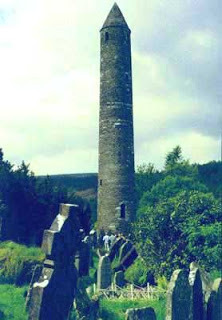 By 822 Viking raids occurred annually, and a few years later, they made incursions inland. By 840 their attacks were concentrated on the monastic communities. The monasteries were early targets. These undefended sanctuaries, the deposits of treasures of the kings, were primarily of wood and were destroyed by the raiders. Many of the illuminated manuscripts were among the treasures that were destroyed by the illiterate Norsemen–the Book of Kells being a notable survivor. Still later, they established settlements along waterways: Dublin by the River Liffey, in Waterford by the River Barrow, in Limerick by the River Shannon, and in Anagassan by the River Boyne. (Dublin would remain a separate kingdom and would be ruled by a Norse king from 853, when the dynasty of Olaf was created, until long after the final dissolution of Viking political power in 1014, a period of more than 160 years.)
By 822 Viking raids occurred annually, and a few years later, they made incursions inland. By 840 their attacks were concentrated on the monastic communities. The monasteries were early targets. These undefended sanctuaries, the deposits of treasures of the kings, were primarily of wood and were destroyed by the raiders. Many of the illuminated manuscripts were among the treasures that were destroyed by the illiterate Norsemen–the Book of Kells being a notable survivor. Still later, they established settlements along waterways: Dublin by the River Liffey, in Waterford by the River Barrow, in Limerick by the River Shannon, and in Anagassan by the River Boyne. (Dublin would remain a separate kingdom and would be ruled by a Norse king from 853, when the dynasty of Olaf was created, until long after the final dissolution of Viking political power in 1014, a period of more than 160 years.)
After many incursions into parts of Ireland, the Irish began fighting back. While the Norwegian Vikings held their main winter camps, new aggression by Danish intruders held off any advancement. In the mid 800s many Vikings were killed by the Irish, however, by the end of the century, the Scandinavians had integrated into Irish life through the taking of wives and settling on the shores. In the latter half of the century, the Danes and the Norwegian Vikings were fighting each other.
Eventually the raids ceased and many of the Vikings became mercenaries, fighting for whichever warring faction of the four provinces needed aid. But after this period, most Norse became known as merchants and traders. Second generation Vikings often had Irish names and many converted to Christianity. Furthermore, ancient Irish and Viking design became intermingled as the dual cultures thrived. The Norse towns and adjoining regions–primarily Dublin, and later, Limerick–became client kingdoms after the Irish pattern. In 1000 A.D. the Norse introduced the first native coinage into Ireland.
The Viking period in Ireland lasted about 220 years, with the period of strongest influence lasting a mere 140 years--from the establishment of Dublin until its sack by the King of Tara. But aspects of Irish culture, linguistics, and politics would be influenced for all time by the Norse presence.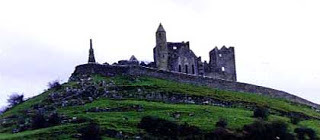 This is but an overview of the Viking period. A later article will go into detail about the conflict between the high Kings of Ireland and the Viking rulers. For further reading the Viking Answer Lady has an excellent, detailed history of the period. Also check out an articleby Renee Vincent, author of the recently published novel Ræliksen set in Viking Ireland.
This is but an overview of the Viking period. A later article will go into detail about the conflict between the high Kings of Ireland and the Viking rulers. For further reading the Viking Answer Lady has an excellent, detailed history of the period. Also check out an articleby Renee Vincent, author of the recently published novel Ræliksen set in Viking Ireland.
If this whets your appetite to learn more about Viking Ireland, why not visit Dublinia, a Viking and Medieval Museum right in Dublin City Centre located at the crossroads of St Michael’s Hill, Patrick St., and Thomas St. Dublinia is connected to Christ Church Cathedral by a medieval footbridge. Open daily throughout the year (10.00am to 5.00pm April to September and 10.00am to 4.30pm October to March). Admission is €6.95 for adults, €5.95 students and seniors and €20.00 for a family of four (2 adults and 2 children). Group and combined rates also available (combining Dublinia and Christchurch Cathedral), also there's a guided tour of Viking and Medieval Dublin with costumed guides stationed around the exhibits to provide more information.
ABOUT THE AUTHOR...
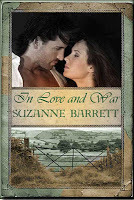 After working twenty-five years for a major defense contractor, Suzanne left engineering to write full time. Nine years after beginning her first novel (set in Ireland) she “got the call.” Suzanne has published eleven novels, both contemporary and historical and now writes exclusively for Turquoise Morning Press. But writing is only one of her hobbies. Suzanne creates artisan jewelry, gardens in her mountain acreage in Northern California and enjoys cooking, water fitness, searching the coastal beaches for sea glass and many other hobbies. She reviews for major publications and writes non-fiction articles for an Irish website.
After working twenty-five years for a major defense contractor, Suzanne left engineering to write full time. Nine years after beginning her first novel (set in Ireland) she “got the call.” Suzanne has published eleven novels, both contemporary and historical and now writes exclusively for Turquoise Morning Press. But writing is only one of her hobbies. Suzanne creates artisan jewelry, gardens in her mountain acreage in Northern California and enjoys cooking, water fitness, searching the coastal beaches for sea glass and many other hobbies. She reviews for major publications and writes non-fiction articles for an Irish website.
 Her latest books are Loving Lukeand The Prodigal Lover, available at Amazon and other online stores. Both novels are set in Northern California. In Love and War, a novel of Ireland is set in County Waterford where Suzanne spent a winter researching Irish history.
Her latest books are Loving Lukeand The Prodigal Lover, available at Amazon and other online stores. Both novels are set in Northern California. In Love and War, a novel of Ireland is set in County Waterford where Suzanne spent a winter researching Irish history.
The Vikings in Irelandby Suzanne Barrett
 By the ninth century Irish education had advanced to the degree that at the court of Charlemagne Irish masters taught at palace schools. However, as learned monks now had practical reasons to leave their homeland, the way was paved for the Viking expansion.
By the ninth century Irish education had advanced to the degree that at the court of Charlemagne Irish masters taught at palace schools. However, as learned monks now had practical reasons to leave their homeland, the way was paved for the Viking expansion.Many of the Norsemen were pirates and traders, and they came from the Scandinavian North. That they were Norwegians and Danes is known, however, ancient historians dealt harshly with all Viking invaders and it is not clearly known if those called Finn-Gaill were of Norwegian descent and those called Dubh-Gaill were of Danish stock. The term Gaill means Gentile or foreigner.
Ireland had been free from invasion since prehistoric times and Christian for three hundred years by the time of the first Viking incursion. The land was nominally ruled over by the Árd Rí, or High King of the Irish. In truth, it was more a collection of petty kingdoms which gave lip service only to the ceremonial overlordship of the Ui-Naill and was constantly warring over one thing or another. The North of Ireland was ruled by the Ui-Naill family. Meath was ruled by the Southern Ui-Naill, while Ulster was ruled by Njall-Caille of the northern Ui-Naill. By the advent of the Vikings, the Árd Rí was no longer "King of Tara" except in name, for inasmuch as he ruled, he did so from Derry, which was not even in the kingdom of Meath where Tara stood.
 The earliest record of Viking attacks is around 795 A.D. The islands of Inismurray and Inisbofin on the northwest were among the first places attacked. After the initial shock, the Irish rallied, but the nature of the raids also changed, and settlement succeeded raid. By 807, the Vikings had won a foothold on Inismurray and Lindisfarne. During the early years they were beaten back, but by 820 Viking fleets once more appeared along the coasts of Ireland and plundered Howth, Wexford and Cork. In 841 Vikings founded a permanent settlement at the mouth of the River Liffey on the east central coast. This rugged settlement was the foundation for the city of Dublinwith similar bases established at Waterford in 914 and at Limerick in 922. These bases most likely were wooden stockades built around beached longboats but eventually they would become trading centers and the forerunners of urban centers in Ireland, setting them apart from the prior rural pattern of Irish history.
The earliest record of Viking attacks is around 795 A.D. The islands of Inismurray and Inisbofin on the northwest were among the first places attacked. After the initial shock, the Irish rallied, but the nature of the raids also changed, and settlement succeeded raid. By 807, the Vikings had won a foothold on Inismurray and Lindisfarne. During the early years they were beaten back, but by 820 Viking fleets once more appeared along the coasts of Ireland and plundered Howth, Wexford and Cork. In 841 Vikings founded a permanent settlement at the mouth of the River Liffey on the east central coast. This rugged settlement was the foundation for the city of Dublinwith similar bases established at Waterford in 914 and at Limerick in 922. These bases most likely were wooden stockades built around beached longboats but eventually they would become trading centers and the forerunners of urban centers in Ireland, setting them apart from the prior rural pattern of Irish history.The Irish kings built fleets against the invaders, and the Norsemen built towns. Stone superseded wood and eventually became the chief building material and round towers became lookouts.
 By 822 Viking raids occurred annually, and a few years later, they made incursions inland. By 840 their attacks were concentrated on the monastic communities. The monasteries were early targets. These undefended sanctuaries, the deposits of treasures of the kings, were primarily of wood and were destroyed by the raiders. Many of the illuminated manuscripts were among the treasures that were destroyed by the illiterate Norsemen–the Book of Kells being a notable survivor. Still later, they established settlements along waterways: Dublin by the River Liffey, in Waterford by the River Barrow, in Limerick by the River Shannon, and in Anagassan by the River Boyne. (Dublin would remain a separate kingdom and would be ruled by a Norse king from 853, when the dynasty of Olaf was created, until long after the final dissolution of Viking political power in 1014, a period of more than 160 years.)
By 822 Viking raids occurred annually, and a few years later, they made incursions inland. By 840 their attacks were concentrated on the monastic communities. The monasteries were early targets. These undefended sanctuaries, the deposits of treasures of the kings, were primarily of wood and were destroyed by the raiders. Many of the illuminated manuscripts were among the treasures that were destroyed by the illiterate Norsemen–the Book of Kells being a notable survivor. Still later, they established settlements along waterways: Dublin by the River Liffey, in Waterford by the River Barrow, in Limerick by the River Shannon, and in Anagassan by the River Boyne. (Dublin would remain a separate kingdom and would be ruled by a Norse king from 853, when the dynasty of Olaf was created, until long after the final dissolution of Viking political power in 1014, a period of more than 160 years.)After many incursions into parts of Ireland, the Irish began fighting back. While the Norwegian Vikings held their main winter camps, new aggression by Danish intruders held off any advancement. In the mid 800s many Vikings were killed by the Irish, however, by the end of the century, the Scandinavians had integrated into Irish life through the taking of wives and settling on the shores. In the latter half of the century, the Danes and the Norwegian Vikings were fighting each other.
Eventually the raids ceased and many of the Vikings became mercenaries, fighting for whichever warring faction of the four provinces needed aid. But after this period, most Norse became known as merchants and traders. Second generation Vikings often had Irish names and many converted to Christianity. Furthermore, ancient Irish and Viking design became intermingled as the dual cultures thrived. The Norse towns and adjoining regions–primarily Dublin, and later, Limerick–became client kingdoms after the Irish pattern. In 1000 A.D. the Norse introduced the first native coinage into Ireland.
The Viking period in Ireland lasted about 220 years, with the period of strongest influence lasting a mere 140 years--from the establishment of Dublin until its sack by the King of Tara. But aspects of Irish culture, linguistics, and politics would be influenced for all time by the Norse presence.
 This is but an overview of the Viking period. A later article will go into detail about the conflict between the high Kings of Ireland and the Viking rulers. For further reading the Viking Answer Lady has an excellent, detailed history of the period. Also check out an articleby Renee Vincent, author of the recently published novel Ræliksen set in Viking Ireland.
This is but an overview of the Viking period. A later article will go into detail about the conflict between the high Kings of Ireland and the Viking rulers. For further reading the Viking Answer Lady has an excellent, detailed history of the period. Also check out an articleby Renee Vincent, author of the recently published novel Ræliksen set in Viking Ireland.If this whets your appetite to learn more about Viking Ireland, why not visit Dublinia, a Viking and Medieval Museum right in Dublin City Centre located at the crossroads of St Michael’s Hill, Patrick St., and Thomas St. Dublinia is connected to Christ Church Cathedral by a medieval footbridge. Open daily throughout the year (10.00am to 5.00pm April to September and 10.00am to 4.30pm October to March). Admission is €6.95 for adults, €5.95 students and seniors and €20.00 for a family of four (2 adults and 2 children). Group and combined rates also available (combining Dublinia and Christchurch Cathedral), also there's a guided tour of Viking and Medieval Dublin with costumed guides stationed around the exhibits to provide more information.
ABOUT THE AUTHOR...
 After working twenty-five years for a major defense contractor, Suzanne left engineering to write full time. Nine years after beginning her first novel (set in Ireland) she “got the call.” Suzanne has published eleven novels, both contemporary and historical and now writes exclusively for Turquoise Morning Press. But writing is only one of her hobbies. Suzanne creates artisan jewelry, gardens in her mountain acreage in Northern California and enjoys cooking, water fitness, searching the coastal beaches for sea glass and many other hobbies. She reviews for major publications and writes non-fiction articles for an Irish website.
After working twenty-five years for a major defense contractor, Suzanne left engineering to write full time. Nine years after beginning her first novel (set in Ireland) she “got the call.” Suzanne has published eleven novels, both contemporary and historical and now writes exclusively for Turquoise Morning Press. But writing is only one of her hobbies. Suzanne creates artisan jewelry, gardens in her mountain acreage in Northern California and enjoys cooking, water fitness, searching the coastal beaches for sea glass and many other hobbies. She reviews for major publications and writes non-fiction articles for an Irish website.
 Her latest books are Loving Lukeand The Prodigal Lover, available at Amazon and other online stores. Both novels are set in Northern California. In Love and War, a novel of Ireland is set in County Waterford where Suzanne spent a winter researching Irish history.
Her latest books are Loving Lukeand The Prodigal Lover, available at Amazon and other online stores. Both novels are set in Northern California. In Love and War, a novel of Ireland is set in County Waterford where Suzanne spent a winter researching Irish history.
Published on August 15, 2012 02:30
August 14, 2012
The Reality of Pirates in 1717 – Not Quite Pirates of the Caribbean by Claire Ashgrove
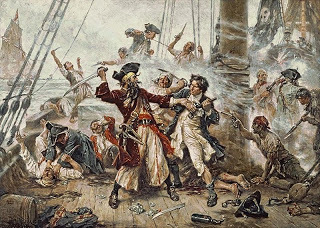 Today on History Undressed I'd like to introduce you to our guest author today, Claire Ashgrove! She's talking pirates...
Today on History Undressed I'd like to introduce you to our guest author today, Claire Ashgrove! She's talking pirates...
Good morning everyone. Thank you so much for hosting me today! I wanted to do a little fact versus reality comparison for you all today, in relation to my debut historical romance, Bound by Decency.
The Reality of Pirates in 1717 – Not Quite Pirates of the Caribbean
Disney has done a great deal to influence our perception of a pirate and tell us what a pirate should, or should not be. We all love Jack Sparrow – who wouldn’t with Johnny Depp behind the name? But the truth is, the reality of pirates aren’t quite what the production companies would like us to believe. Let’s break a few myths, shall we?
1. The Dialect – They really speak like this, yes?
We have a national Talk Like A Pirate Day, how could it be otherwise? Truth is… no. The exaggerated rrs and the catch-phrases we all associate with pirates originate not from history annals, but from Long John Silver, 1954. Did pirates have a brogue? Probably. In fact, most likely. And it was also most likely a similar variation of the Cockney accent. The poor, uneducated British man’s speech. If not, they’d possess the natural English brogue we associate with the land. In short—if they were educated, they’d speak like our ladies and lords we love of Regency romance. If they were uneducated and (typically) poor, it would resemble more Eliza Doolittle.
2. All Pirates Were Drunks – Um… well… yes and no.
To examine this, waterhas to be considered. Finding potable water on board a ship was really hard. They might leave port with several barrels, but bacteria would set in, or they’d flat run out. Which left them with cleaner, healthier rum, wine, whiskey, and alcohol in general. So yes, indeed, they drank a lot of spirits.
But here’s the crux: Every agreement that crews drew up reference severe penalties for failure to adhere to duties or abandon posts, and some reference penalties for being drunk at the time of engagement. Given that it’s rather obvious if a person is truly drunk, it stands to reason attention to duties often suffers, the drawback to being drunk isn’t often worth the indulgement. Who really wants to die for drinking past 8 bells? So it stands to reason that while alcohol infused their daily lives, drinking was done in moderation aboard ship, with attention to sobriety. (Five glasses consumed over a day, as opposed to five in an hour). The real partying came when the ship was at port.
3. Pirates Wanted Gold, And They Buried it Too!
Ahh… the romance of fiction. Did pirates want gold? Well—do you? Of course they wanted gold, and they certainly wouldn’t leave it behind on a ship they raided. But the vast majority of pirating didn’t involve riches. It involved the simple things needed for survival on a ship. Recall that spoiled water? Yup, they’d raid because they needed fresh. This goes hand-in-hand with rotten food, tobacco, medicines, guns, ammunition, and things like canvas for battered sails.
Then there’s the whole burying these treasures part. Ignoring the fact that most of what they stole were consumables, we can thank Treasure Islandfor this common misconception. Fact is, no legitimate treasure map has ever been found. Nothing exists to suggest they buried riches, and for men who partied hard in port—they spent what they acquired as fast as they could. Buried treasure doesn’t really fit the bill. Unless you’re speaking of the rare incident when excessive coin was discovered. In such cases, a pirate captain who naturally would’t trust his crew to watch over the take, might hide his riches. But he would do so in a place he could readily get to. Which nixes the idea of complex pirate maps.
So, there you have it. A peek at the reality of pirates in the early 1700s. Disney has given us great memories, but before you claim Sparrow as the epitome of pirate life, consider some of these more unromantic facts!
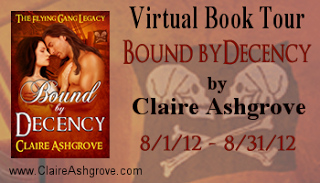
ENTER CLAIRE'S BLOG TOUR GIVEAWAY!
Giveaway Details:
Claire will be giving away a $25.00 Amazon Gift Card to one random commenter during the tour. Follow the tour – the more times you comment, the better your chances of winning! Complete schedule can be found here.
ABOUT THE AUTHOR...
Claire Ashgrove has been writing since her early teens and maintained the hobby for twenty years before deciding to leap into the professional world. Her first contemporary novel, Seduction's Stakes, sold to The Wild Rose Press in 2008, where she continues to write steamy, sexy stories for the Champagneand Black Rose lines. Adding to these critically acclaimed romances, Claire’s paranormal romance series, The Curse of the Templars debuted with Tor in January 2012. For those who prefer the more erotic side of romance, she also writes for Berkley Heat as the National Bestselling Author Tori St. Claire.
She is an active member of Romance Writers of America, and her local RWA chapters, Heartland Romance Authors, Midwest Romance Writers, North Texas Romance Writers of America, and Celtic Hearts Romance Writers.
Claire lives in Missouriwith her two toddler sons, and too-many horses, cats, and dogs. In her “free” time, she enjoys cooking, winning at Rummy, studying Ancient Civilizations, and spending quiet moments with her family, including the critters. She credits her success to her family's constant support and endless patience. To learn more about Claire, visit her on the web at www.claireashgrove.com, or www.toristclaire.com.
ABOUT THE BOOK...
Bound by Decency -- Book One: The Flying Gang Series
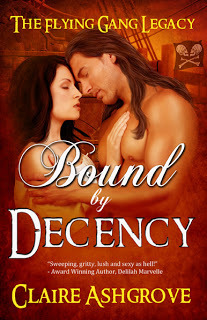 After inheriting a portion of Spain’s Royal Inheritance, Cain left The Flying Gang for a chance at honest wealth. With the secrets of his piracy tucked away, he achieved his lofty aspirations. But when his partner and best friend betrays him to the Royal Navy, Cain’s dreams are ripped to shreds. He’s left with his ship, the tattered remnants of a stolen future, and a piece of Spanish mystery. Wanted by three nations and destined for the gallows, he returns to the legendary band of buccaneers for one purpose -- vengeance.
After inheriting a portion of Spain’s Royal Inheritance, Cain left The Flying Gang for a chance at honest wealth. With the secrets of his piracy tucked away, he achieved his lofty aspirations. But when his partner and best friend betrays him to the Royal Navy, Cain’s dreams are ripped to shreds. He’s left with his ship, the tattered remnants of a stolen future, and a piece of Spanish mystery. Wanted by three nations and destined for the gallows, he returns to the legendary band of buccaneers for one purpose -- vengeance.Kidnapped by the formidable Cain, IndiaPrescottdiscovers he intends to kill the man she’s to marry. Cain’s story reveals betrayal. Treachery that extends to her as well. Although she holds the key to retribution, Indiarefuses to become another man’s pawn. Freedom lies before her, the liberty to shrug off propriety, make her own decisions, and claim her destiny. But when she uncovers goodness in Cain’s soul and he awakens passion in her heart, she must combat the chains of convention once more.
Only this time India's not fighting society. She’s battling a pirate bent on keeping her decency intact.
EXCERPT...
For a moment, he could do nothing more than stare. Richard had said his intended was lovely, but somehow, Cain had never pictured her as a beauty. Yet now, as she stood before him, her chest heaving with indignation and her hair a sopping mess, he realized Richard had once again played him false. India Prescott wasn’t merely lovely. She was breathtaking.“What in the name of Mary do you think you’re doing?” she snapped. “My father will see you hang for this.”Her sharp tongue yanked Cain out of his stupor. He collected himself quickly, and for the first time since his arrest, gave into a broad grin. “Indeed, he will have to get in line.”India’s eyes widened a fraction, but anger drew delicate brows downward, and those sky-blue eyes narrowed. “I see no amusement in this. Do you have any idea who I am?”As a rumble of laughter broke through the men within earshot, Cain’s humor subsided. His smile faded, and he reached out to twine a thick lock of her hair around his finger. Turning his wrist, he wrapped the silken length around his hand, slowly bringing her closer. So close that the wet fabric straining across her breasts dampened his shirt. The heat of her skin grazed his. “I know well who you are, Miss Prescott.” He ran the back of his free hand across her dainty collar bone, over the slope of her shoulder, then lifted it to draw his thumb across her parted lips. The audible catch of her breath ricocheted through him. So she was not unaffected by him. Good. He could use it to his advantage.His gaze held hers. A flicker of fear passed behind her eyes, but to her credit, she didn’t shrink away. She stood straight and proud, even as she shivered in the stirring breeze. Courage Cain didn’t often encounter from the gentle born. God’s teeth, men far stronger and larger than she didn’t hesitate to grovel at his feet. Yet she, no bigger than a lark, defied him with stubborn silence.Unacceptable.To drive her subservient position as his captive home, he tightened his hold on her hair until she winced. Leaning forward, he lowered his mouth to her ear. “You are the daughter of a powerful man and presently my prisoner, to do with as I will.” Stepping back, he untwined his hand and smirked.India’s palm cracked across his cheek. “Rot in hell!”
Published on August 14, 2012 01:00
August 13, 2012
Weekly Video: Horrible Histories -- Albert and Victoria A Love Story
Man, I love these videos... Another fun bit of history for you!

Published on August 13, 2012 05:57
August 11, 2012
Historical Romance Review: Bound by Decency by Claire Ashgrove
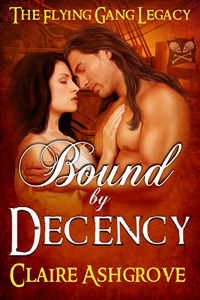 I love a good swashbuckling romance, and Ms. Ashgrove has definitely penned a vibrant, adventurous romantic tale, not to be missed!
I love a good swashbuckling romance, and Ms. Ashgrove has definitely penned a vibrant, adventurous romantic tale, not to be missed!
ABOUT THE BOOK...
Once, Cain sailed with the cutthroats of The Flying Gang, fearless Captain of The Kraken, bound to no one save the sea. After inheriting a portion of Spain’s Royal Inheritance, he resigned the life of brigands for a chance at honest wealth. With the secrets of his piracy tucked away, he achieved his lofty aspirations. But when his partner and best friend betrays him to the Royal Navy, Cain’s dreams are ripped to shreds. He’s left with his ship, the tattered remnants of a stolen future, and a piece of Spanish mystery. Wanted by three nations and destined for the gallows, he returns to the legendary band of buccaneers for one purpose---vengeance.
Kidnapped by the formidable Cain, India Prescott discovers he intends to kill the man she’s to marry, Richard Grey. Cain’s story reveals betrayal. Treachery that extends to her as well. Although she holds the key to retribution, India refuses to become another man’s pawn. Freedom lies before her, the liberty to shrug off propriety, make her own decisions, and claim her destiny. But when she uncovers goodness in Cain’s soul and he awakens passion in her heart, she must combat the chains of convention once more.
Only this time India's not fighting society. She’s battling a pirate bent on keeping her decency intact.
MY REVIEW...
From the moment I began to read, it was evident that Bound by Decency was a well-researched novel. The author has a great handle on the language of ships, the time period, every little nuance, which brought the story vividly alive in my mind.
Cain is bent on revenge, and torn between a life of decency and a life he's made for himself as a pirate. He wars with his ultimate desires and his reputation. The only way he sees to living the life he wants is by gaining his freedom, freedom that was taken by him from someone he trusted, his partner. His revenge leads him to India Prescott--the fiance of his enemy. But she is nothing like what he imagined, and Cain finds that he fights himself more often than anything else.
India too hides behind a facade instead of being the person she wants to be. Society dictates how a lady should act, and she doesn't want to disappoint her father. But...on a ship...there is no Society. And while she refuses to help Cain in his mission for revenge, she can't refuse his kiss.
Together, Cain and India not only burn up the pages with tension, passion, adventure, they learn to accept who they really are, for they bring out the "best" of themselves when together. Bound by Decency is a romantic, adventurous tale, that shows when two people come together, sometimes they learn who they really are.
Recommended read! Well done!
Published on August 11, 2012 05:23



